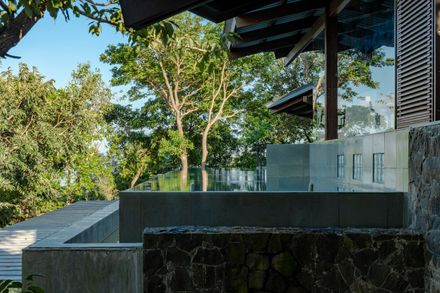Lateral Verandah House
ARCHITECTS
Malik Architecture
STRUCTURE ENGINEERS
Sturdcom/ Global Engineering Services
INTERIOR CONTRACTOR
Raju Bhai
LANDSCAPE ARCHITECTS
Studio Humane
LEAD ARCHITECTS
Kamal Malik, Arjun Malik, Meghana Tipnis, Netramohan Changmai, Sundeep Sarangi
GENERAL CONTRACTOR
Unique Concrete Technologies
INTERIOR CONTRACTOR
Rajesh Parmar, Manoj Suthaar
ROOFING
Epopsi Strumat
PHOTOGRAPHS
Bharath Ramamrutham, Edmund Sumner
AREA
12883 Ft²
YEAR
2022
LOCATION
Pune, India
CATEGORY
Houses
The Lateral Verandah House is, in many ways, a natural extension of the House of Three Streams.
They are located on the same site and were designed concurrently but built in separate phases.
This home is located further down the slope of this densely forested and steep land. The ravines intersected and informed the house.
The House of Three Streams has, at this point, exited the site boundaries and the slopes here are slightly shallower.
The memory of ‘Place’ here is significant; Tung Fort sits in close proximity to the East; the topography of the land is particular; the forestation is dense and the climate is distinct, especially considering the eddying wind currents due to the large expanse of Pawna dam towards the North/East and the low lying hills to the South/South-West.
The monsoon is violent but beautiful and rain rarely falls vertically due to the accompanying wind.
The house is organized over two primary levels, the upper one sheltering the communal spaces, and the lower one holding the sleeping and mechanical areas.
The roof follows the stepping plinth as it adapts to the gradual shift in levels.
It undulates, shifts, sidesteps, hovers, and allows the passage of the hill and of the existing trees as it provides shade and frames the near and distant views.
Its structural morphology of flitched rafters intertwining with the structural ‘Trees’ situates it in the landscape as a natural pause point in the journey down the hill.
Raw basalt walls anchor the proposal to the ground. The familiarity and historical application of this stone in every type of shelter, from the village home to the forts, turns these heavy elements into a built landscape.
The expected sense of witnessing a House is supplanted by something less recognizable yet familiar, something more ephemeral, yet it is visceral. Everywhere, there are allusions to the surroundings and to the past.
The cylinder that rises from the landscape as the House is approached speaks of the fort bastions.
The organizational structure of the House precludes a discernible entry point or fixed boundaries, the ‘made’ and ‘found’ merge, and space and movement flow unhindered, much like an organism that has found its equilibrium in Nature; a special Homeostasis.












































